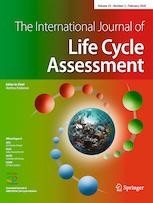Ver ítem
- xmlui.general.dspace_homeCentros Regionales y EEAsCentro Regional Tucumán - Santiago del EsteroEEA FamailláArtículos científicosxmlui.ArtifactBrowser.ItemViewer.trail
- Inicio
- Centros Regionales y EEAs
- Centro Regional Tucumán - Santiago del Estero
- EEA Famaillá
- Artículos científicos
- Ver ítem
A comparative life cycle assessment of the sugarcane value chain in the province of Tucumán (Argentina) considering different technology levels
Resumen
Purpose: The purpose of this work is to quantify the environmental impact of the sugarcane industry in Tucumán (Argentina) through the life cycle analysis (LCA). The distinctive feature is the consideration of different technology levels (TLs) in the agricultural stage: high (HTL), medium (MTL), and low (LTL).
Methods: The scope of the study covers the agricultural and industrial stages through a “from cradle to gate” approach (from sugarcane cultivation
[ver mas...]
Purpose: The purpose of this work is to quantify the environmental impact of the sugarcane industry in Tucumán (Argentina) through the life cycle analysis (LCA). The distinctive feature is the consideration of different technology levels (TLs) in the agricultural stage: high (HTL), medium (MTL), and low (LTL).
Methods: The scope of the study covers the agricultural and industrial stages through a “from cradle to gate” approach (from sugarcane cultivation until production of finished products: sugar and alcohol). The system is divided into Agriculture, Sugar Factory, and Distillery. Data used for the inventory are mainly provided by local experts, sugarcane growers, and processing companies. The characteristics of each TL are taken from a regional classification. For the impact assessment, the CML 2001 model (nine impact categories) is used.
Results and discussion: Regardless of the TL, in most of the impact categories, an important contribution attributable to the use of synthetic agrochemicals is evident. As for the comparison among TLs, the ethanol produced with HTL has less impact values than the ones produced with MTL and LTL in seven categories. These results can be mainly explained by the better cultural yields obtained with HTL, and to the fact that sugarcane is not burnt before harvesting in HTL as it is in MTL and LTL.
Conclusions: This study explores the implications of using different TLs for the agricultural tasks on the sugarcane supply chain in Tucumán, which is characterized by a vertically nonintegrated productive scheme. If practices associated to HTL are implemented, a reduction of the environmental impact is observed in most categories. It is necessary to compare these results with economic and social implications to ensure sustainability of the sugarcane value chain.
[Cerrar]

Autor
Nishihara Hun, Andrea Lorena;
Mele, Fernando Daniel;
Perez, Gonzalo Antonio;
Fuente
The International Journal of Life Cycle Assessment 22 : 502–515 (2017)
Fecha
2017
Editorial
Springer
ISSN
0948-3349
1614-7502
1614-7502
Formato
pdf
Tipo de documento
artículo
Palabras Claves
Derechos de acceso
Restringido
 Excepto donde se diga explicitamente, este item se publica bajo la siguiente descripción: Creative Commons Attribution-NonCommercial-ShareAlike 2.5 Unported (CC BY-NC-SA 2.5)
Excepto donde se diga explicitamente, este item se publica bajo la siguiente descripción: Creative Commons Attribution-NonCommercial-ShareAlike 2.5 Unported (CC BY-NC-SA 2.5)

